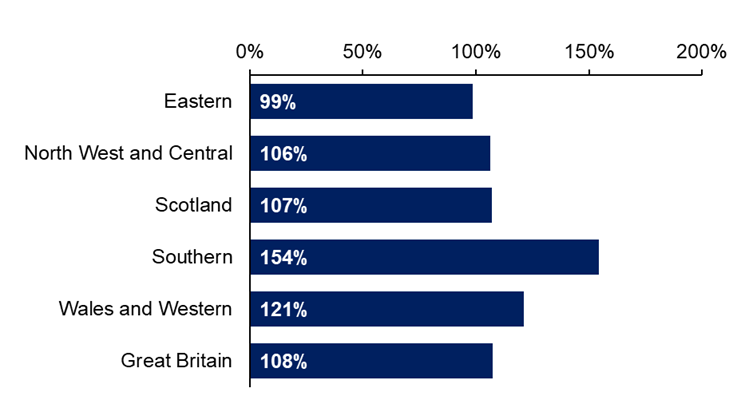Ageing assets need to be carefully managed
Network Rail must maintain and renew its assets in an efficient, sustainable way, while ensuring a safe and operational railway. In CP7, we measure asset sustainability through the Composite Sustainability Index (CSI), with targets set for each region for the end of the control period.
As we noted in our final determination for CP7, funding is constrained, reflecting wider fiscal conditions. Constrained funding means that Network Rail will be spending less on renewals and more on life-extending repairs and maintenance in CP7 than in CP6. As such, it forecasts a small reduction in the residual life of its assets (and therefore CSI), which will require effective risk management activities to be identified and implemented.
Network-wide CSI at end of Year 1 was -0.4, representing a 0.4% decline in overall asset sustainability since the baseline at the end of CP6. This decline is in line with the expected reduction for the year. All regions experienced a similar decline, ranging from approximately -0.3% to -0.4%, which is consistent with the network-wide trajectory required to meet end of CP7 targets.
CSI outturn is affected by Network Rail’s delivery of its asset renewals plans. If renewals volumes are not sustained at the level outlined in the initial delivery plan for the remainder of CP7, there is a risk that asset sustainability could decline beyond the forecasted trajectory – which will make delivering train performance very challenging and will lead to inefficient spend on infrastructure in the future.
Renewals volumes were delivered but future reductions risk CP7 outcomes
Network Rail delivered its overall planned renewal volumes for the year (108% of its plan). Four of the five regions achieved their own targets, delivering more than 100% of their planned volumes. Southern and Wales & Western regions delivered notably more than planned. Scotland, North West & Central and Eastern were broadly on target.
Effective volumes (renewals) percentage completion, by Network Rail region, April 2024 to March 2025

Source: ORR analysis of Network Rail data
Signalling renewals volumes were affected nationally by delays in developing new technology (a version of modular signalling control technology) which led to deferral of key resignalling projects such as Cambridge, Victoria Phase 4 & 5, and West of Scotland Signalling Centre.
While asset renewals delivery was good in Year 1, Network Rail’s plan for renewals in the remainder of CP7 has been volatile. It is now planning fewer renewals in Year 2 and across the control period compared to its initial delivery plan. This planned reduction risks additional deterioration of its assets which may lead to more asset failures and therefore disruption to train services in the long-term. This would mean higher renewals volumes, and therefore costs, required in future control periods. It may also impact on Network Rail’s delivery of efficiency. This is of most concern for Eastern, North West & Central, and Southern regions. In North West & Central, a large reduction in planned earthworks renewals is particularly evident.
As set out later in this report, we recognise the fiscally challenging environment in which Network Rail is operating in CP7 which is putting pressure on delivery. We have informed Government funders of our concerns in our RF11 letter on Network Rail’s latest forecast, which will be published in due course.
Asset reliability remained steady
Key measures of railway asset reliability (such as the overall number of service-affecting failures and the composite reliability index (CRI)) remained steady across the network in Year 1, supported by good delivery of renewals in the year. Network Rail exceeded its own CRI targets in four regions: Network Rail Scotland, Wales & Western, Eastern, and Southern. However, North West & Central underperformed against its CRI target, impacted mainly by worsening reliability of track and electrical power assets.
With Network Rail now planning fewer renewals in future years compared with its original delivery plan, there is a risk that additional deterioration of its assets may lead to more asset failures and therefore disruption to train services in the long-term. As above, this is of most concern for Eastern, North West & Central, and Southern regions.
Network Rail needs to improve its maintenance reporting and manage risks to future maintenance delivery
Given constrained funding and therefore lower renewals, Network Rail is relying more heavily on its maintenance practices to manage risks. We are therefore focused on understanding how well it is delivering maintenance activity.
We commissioned an independent reporter to look at this. The reporter found that Network Rail had sufficient maintenance capacity to deliver the planned volumes in the first and second years of the control period. But it found there may be risks to delivering increased volumes of maintenance work in years three to five and better planning tools were needed to model this. The reporter recommended specific measures that Network Rail’s central function (Technical Authority) should take to improve tools for planning of maintenance activity in these years, and we will review its progress against these.
We have also reviewed the number of maintenance hours delivered by Network Rail compared to its plans. In total, its reporting suggests it has delivered broadly in line with its planned hours, but there is regional variation. However, these numbers are aggregated and include many different types of activity which makes it difficult to draw any insight on whether maintenance delivery is sufficient to mitigate risks. We are working with Network Rail to improve its reporting and insight about maintenance delivery by region.
Network Rail did not deliver structures and buildings examinations and assessments in line with its standards
We remain concerned about Network Rail’s management of its structures examinations and assessments as these are not being delivered in line with its standards. If not addressed, this could risk undetected faults, safety hazards and operational disruptions, with the potential for significant effect on passengers, members of the public and Network Rail’s workforce.
In 2023, Network Rail provided regional plans to reduce the backlog of structures examinations. We have reviewed delivery against these plans. In July 2024, we wrote to Network Rail acknowledging some progress in delivery of the improvement plans but noting that regions had not met their year-end compliance targets, with particular concerns in North West & Central and Southern. We are therefore continuing our enhanced monitoring.
During Year 1, ORR identified a significant further non-compliance against standards, in that Network Rail lacked up-to-date structural assessments for structures and operational properties (such as stations). Structural assessments are undertaken to determine the load carrying capacity of a structure. This meant that Network Rail did not have some of the essential information required to make decisions about how to manage these assets.
Network Rail regions responded to our concerns with initial high-level recovery proposals for structural assessments. We reviewed these, drawing on both our rail safety and our economic delivery (asset management) expertise. We found that the regions’ proposals lacked sufficient detail to provide us with confidence that they will be delivered. In February 2025 we wrote to Network Rail requiring it to ensure that risk assessments were in place for all non-compliant assets. This was achieved by the end of April 2025. We also required Network Rail to complete all assessments for assets with no recorded capacity by the end of February 2026. Network Rail has accepted this, and we will monitor progress.
Network Rail Scotland and Eastern region have now produced detailed structural assessment recovery plans, and we are awaiting the same from the other regions. We have also sought further assurance from Network Rail’s Technical Authority on progress.
Given the above concerns, we are commissioning an independent reporter review of Network Rail’s structural examinations and assessments.
During the year, we also found a high level of non-compliance in earthworks examinations in Wales & Western. In response, the region now plans to increase supplier capacity in Year 2 and for the remainder of the control period. We will continue to monitor progress against its improvement trajectory.
Monitoring vegetation management improvement plans
In Year 1, we raised concerns with Network Rail’s regions and its Technical Authority about the quality of its information on lineside vegetation. Management of lineside vegetation is important as vegetation growth can lead to issues such as obscured signals, damage to overhead lines, trees on the line and trains striking vegetation which may impact train performance and may lead to potential reliability and/or safety risks. If information on lineside vegetation is of poor quality, Network Rail cannot manage vegetation systematically and in line with its own standards and cannot plan work or mitigate these risks effectively. We considered the quality of Network Rail’s information on its lineside vegetation management with the support of both our rail safety and economic expertise.
Since we raised our concerns with Network Rail, it has responded with an improvement plan. We have started to see this deliver improving trends, with more of the network having vegetation condition data. We will continue to monitor delivery of actions over the coming year.
We are also undertaking a targeted assurance review of Network Rail’s vegetation work bank planning and change control. The aim of the review is to assess the effectiveness of how it spends funding, monitors delivery and manages change to its vegetation plans in CP7.
Delayed on-track machine strategy
On-track machines are critical for the effective maintenance and renewal of the rail network. If used effectively they are an enabler, supporting better maintenance outcomes which, in turn, contribute to managing safety and performance risks. To ensure these activities are delivered efficiently and aligned with best practice, Network Rail requires a clear, long-term on-track machine strategy. Given the long asset lifespan of these assets, the strategy should span multiple control periods.
Despite regular engagement and writing to Network Rail, a long-term on-track machine strategy is still not in place. Network Rail has now shared its plans for developing the strategy with ORR — a step forward that reflects our continued pressure. However, we remain concerned that the process remains at an early stage, with limited evidence of tangible progress. We will continue to press Network Rail to develop this strategy during the coming year.

